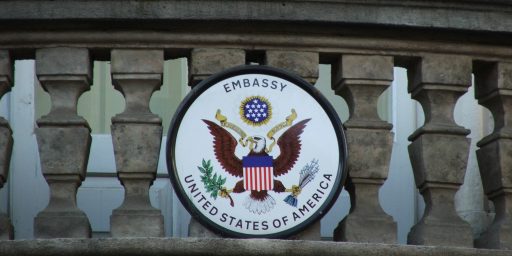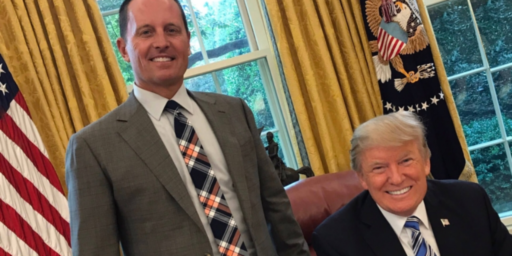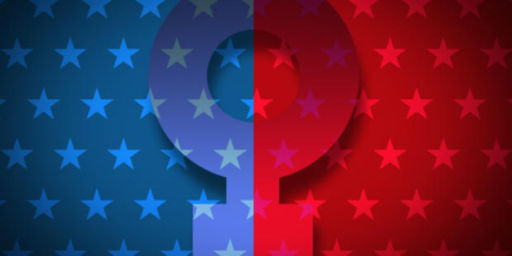Where Are The Women?
What hath a fury greater than a woman scorned? Hundreds of scorned women with Twitter accounts.
The gang at Foreign Policy magazine released their periodic Twitterati 100 list of “who’s who of the foreign-policy Twitterverse in 2012.”
It’s the third iteration of the list and the first not featuring yours truly. That was, alas, inevitable, given that 100 is a finite number and the number of bigger names joining Twitter is exploding. And even more so when the list includes a dozen “all-around news” celebrities and tries to include a smattering of tweeters from as many regional sub-specialties as possible. The place where I most naturally fit, the list of Wonks, includes only ten names and there’s none whom I’d bump to include myself. Especially since I’m a generalist and most of the people on the list are regional or technical experts.
Like most of these exercises, whether it’s the 100 Greatest Guitarists, the 100 Best Movies, or whathaveyou, the purpose of the Twitterati 100 is to generate pageviews and discussion. And it seems to have succeeded on both counts.
The main buzz surrounding this year’s list is that it’s rather short on women. Someone calling herself Elasti Girl notes that there are only “9 women + 93 men” if you don’t count the add-on list of FP staffers who tweet. This, in turn, has sparked several lists suggesting women who tweet about foreign policy issues that people should consider following.
That’s all to the good. Indeed, I actually follow quite a few of the female tweeters on these lists and don’t follow several of the 93 men who made the cut. While I pay some attention to these lists for suggestions, my follower list has grown organically based on who people I follow are having conversations with.
Still, as with the discussions about pop culture lists, it only makes sense to talk about which women ought to make the list in conjunction with which men ought to be bumped off it to make room.
The obvious first target would be the dozen “All-Around News and Views” folks, which at first don’t seem to belong on the list. Then again, at least five of them actually do have legit foreign policy credentials and tweet on issues directly relevant to FP’s audience.
On the Politicians And Diplomats list, only UN Ambassador Susan Rice is a woman. I don’t follow despots Hugo Chavez and Paul Kagame, who might be awesome tweeters, but let’s bump them just out of general principle. So, which women who hold active, prominent roles should we add in their stead? Aside from Rice, I can’t off the top of my head think of any who are also prolific tweeters, but surely there must be at least two?
Similarly, the Economics list has only one woman, Megan Greene. It’s not my field, so I don’t really have suggestions for additions. Megan McArdle comes to mind, although she’s not particularly active on Twitter.
I won’t bother going through the regional lists, as I just don’t know who the players are well enough to comment. The only female omission that stuck out at me was Morehouse’s Laura Seay from the Africa list. She’s got twice my following and is very active, indeed, on the subject.
Lauren Jenkins spun off a related discussion when she wondered “how many women were involved in coming up with the #FPtwitterati list.” Caitlin Fitz Gerald added, ”How many women are on the editorial staff at FP?”
While I haven’t the foggiest how FP came up with the list, their Masthead helps us answer the second question. It turns out, about a dozen, or roughly a third of the staff. Among them: the Editor in Chief, Deputy Managing Editor, Copy Chief, Assistant Managing Editor, and Deputy Art Director.
Is that enough? What should the ratio be?
The easy answer is that it just doesn’t matter. So long as leading foreign policy magazines, think tanks, universities, government institutions, and so forth hire the best qualified people without regard to gender (or race, ethnicity, etc.) the chips should fall where they may. But, surely, the number of women on the staff or on these lists is an indicator of something. And, given our history, that something could be a legacy of oppression–or even its continuation.
My more benign theory is that, while the number of women interested in and becoming qualified to participate in the foreign policy and national security professions has come pretty close to matching the number of men, the talent pool hasn’t quite evened out yet. That’s especially true on the security side, which has traditionally involved a detour as a military officer.
Certainly, when I was getting into the business a quarter century ago, women were few and far between. Most of the graduate students in the relevant fields were still male and the vast majority of the professors, think tankers, and prominent commentators were, too. And the few women tended to go into the “softer” fields like human rights and development.
That seems to have changed rather dramatically in the last fifteen years or so. More and more women are making the early education and career choices necessary to become prominent actors in the field. We’ve seen that in political appointments, with the gender barrier shattered in posts such as UN Ambassador, Secretary of State*, and National Security Advisor. We haven’t yet had a female Secretary of Defense or CIA Director but we’ve had a lot of women a level or two down at both places; the day is coming. (My guess is the first woman SECDEF will have serious uniformed military experience. A Janine Davidson, say.)
It’s rather odd, actually, to live in a world where we have a woman Secretary of State (who barely missed out on being the first woman president of the United States) and a woman UN Ambassador and people are still worried that we don’t have enough women being recognized for their ability to send off 140 character quips on the Internet.** But that day, too, shall one day come.
__________
*So much so that Madeline Albright likes to joke that maybe one day a white man will be able to hold the post again. The last one: Warren Christopher, who Albright replaced in January 1997.
**Which, as a comment from Katherine Maher reminds me, evokes a goodly number of words spilled some years back on the related “Where are the Woman Bloggers?” issue. I suspect that the nature of the medium might be one that leverages personality traits more common to males.







“So long as leading foreign policy magazines, think tanks, universities, government institutions, and so forth hire the best qualified people without regard to gender (or race, ethnicity, etc.) the chips should fall where they may.”
Which is exactly what every priveleged white male says to defend the system of white male privelege. Few women CEOs? It’s ’cause those gals wanna run off and have babies. Few minorities on boards of major corporations? It’s all a merit system, completely color-blind.
It’s nice to know that in our completely fair system, the cream always rises to the top. Of course, to maintain the illusion that this is a completely fair system, we must merely ignore the fact that cream is by definition white and rich.
Perhaps the women realize the140-character limit on Twitter is waaaaay too small to do justice to what they think. But is just right for what men think.
@wr: That’s the point of the paragraph. While “hire the best without regard to gender, etc.” is the easy answer, outcomes tell us something and we have a history of hard and soft discrimination to contend with.
@sam: That’s likely disproportionately true. There’s a reason the really successful FP tweeters skew young and male. Older experts are generally more skeptical and women maybe more reticent. But that’s beginning to change as Twitter itself gains steam. Quite a few graybeards have joined and succeeded over the last couple of years and some women, such as Anne Marie Slaughter and Susan Rice, are among them. Certainly, there are a lot of 20-something women in my FP twitter list who are good at the snark.
@James Joyner: Yes, I misread the second half of your paragraph. My apologies.
Hi, @katrinskaya, aka ElastiGirl here. We compiled a list of women twitterati that should have been included – you can find it here. FP’s Blake Hounshell reached out to us and asked us to cull it to 100 – it will be published in short order. Laura Sealy, of course, is included, as are many other great voices FP should have considered. It took a group of about ten or so determined women from varying fields (I work in international human rights and tech, for instance) about two hours to come up with 150 or names. Not hard, @FP_Magazine 🙂
Maybe you can find a few good ones to follow when they publish it but check out the full version for some great new and familiar voices FP missed.
Best,
Katrin
If a woman ever says anything in under 140 characters it’s never good.
J-Dub,
In my experience, a woman doesn’t even need to speak to indicate how much trouble a man is in.
@Katrin Verclas: Great. It’s probably not hard to find a list of 100 FP women to follow on Twitter. I’m probably following 200+ myself. Now: combine that with FP’s list and cull THAT to 100. That is, how many of your women make the big list? And which men get booted to make room for them?
@sam:
We have a winner.
Tom Friedman might have said the same thing using 1000 words (what’s that? 8000 characters?)